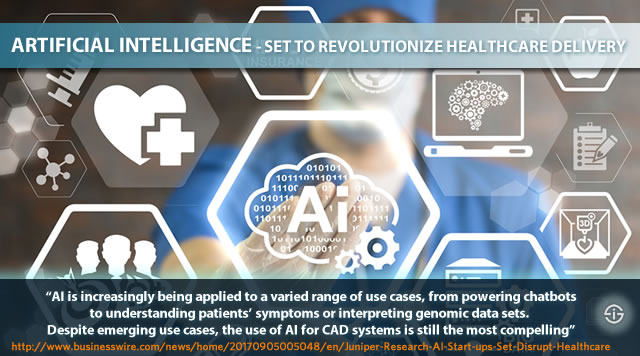AI is being applied to ever more technologies used in healthcare delivery, ranging from the IoT and big data to chatbots. However, the main use case where AI will disrupt healthcare is that of on computer aided diagnosis. Research overview.
Healthcare is in digital transformation, both on the healthcare provider and payer side. Research indicates that healthcare delivery now is ready to be disrupted by artificial intelligence (AI) and AI start-ups between 2017 and 2022. Annual spending on computer aided diagnosis (CAD) systems and evolutions in this field will be impacted as a result.
Computer aided diagnosis systems are expected to enhance speed and accuracy of patient diagnoses and reduce pressure on doctors, among others by better accuracy of the CAD systems.
Annual spending on computer aided diagnosis systems will reach $800 million globally by 2022, as AI start-ups exert greater impact on healthcare delivery (Juniper Research)
Artificial intelligence increasingly won’t just be significant in CAD systems, it is becoming important across the several other technologies driving the digital health market. On top of artificial intelligence, these digital technologies include several areas such as IoT and biosensing, remote patient monitoring, chatbots, digital voice assistants, healthcare wearables and indeed, blockchain, who will all increasingly be integrated into healthcare systems.

AI: impacting ever more healthcare delivery use cases and technologies
It’s obvious that many of these technologies and phenomena go hand in hand. Artificial intelligence is already present in several “combinations”, yet more applications of AI are changing the market.
There is clearly a link between artificial intelligence and chatbots, just as there is a link between AI and healthcare IoT applications or between AI and computer aided diagnosis systems as such. As a matter of fact, the link between AI and IoT is driving the future evolutions in the latter area.
We can keep combining the various technologies if we add less “recent” technologies such as big data (think analytics, insights and the role of AI), EHR systems, telehealth/telemedicine and mHealth applications which are all evolving themselves, with ongoing cloud deployment as the inevitable result and cloud as the backbone of the data analysis and application layers which are needed everywhere.
The main use case for applying AI: computer aided diagnosis systems
The evolutions and adoption/integration patterns of the various technologies – and the role of AI in it all – are covered in new research by Juniper Research.
In the announcement of the research on September 5th, 2017, Juniper Research zoomed in on some of the digital technologies that are revolutionizing healthcare delivery and specifically on artificial intelligence which is being applied to use cases from chatbots and Big Data analytics solutions in areas such as doctor’s notes in an EHR system to processing more complex data systems, the understanding of patients’ symptoms and interpretation of genomic data sets.
The use of AI for CAD systems can generate significant cost savings, forecast at $126 million for first-line CAD systems in 2022 (Juniper Research)
Yet, the most compelling use case for AI in healthcare delivery is that of computer aided diagnosis systems, Juniper states in the announcement.
According to the press release annual spending on computer aided diagnosis or CAD systems will reach $800 million globally by 2022 with artificial intelligence and the various AI start-ups, mentioned in the report, as drivers. Juniper Research also expects that by 2022 each year 8.4 million chronic disease scans will be fed into first-line CAD systems.
The reason why despite several new use cases to apply AI, using AI for computer aided diagnosis systems is seen as the key one has everything to do with cost savings, an eternal challenge in healthcare: to be precise, applying AI to CAD systems would result in an impressive cost saving of $126 million for first-line CAD systems in 2022, according to Juniper. The company sees an increasing integration of AI, EHR systems and analytics platforms into one system as an almost logical consequence. The challenge ahead for all those AI start-ups and AI overall? Trust is one of them.
Top image: Shutterstock – Copyright: Panchenko Vladimir – All other images are the property of their respective mentioned owners.

